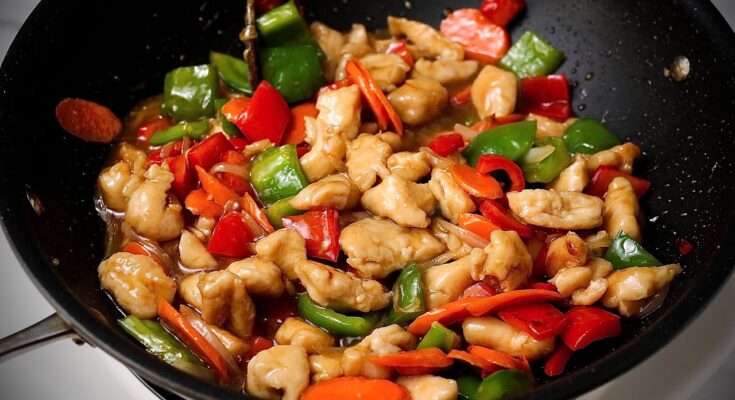Stir Fry Chicken Recipe: There’s something magical about a sizzling pan, the smell of garlic and ginger hitting hot oil, and the colorful burst of fresh veggies—yep, we’re talking about stir fry chicken! It’s one of those dishes that checks all the boxes: fast, healthy, flexible, and downright delicious. You can whip up a restaurant-quality meal in less than 30 minutes, and the best part? You can use whatever you have on hand. Chicken stir fry is like that dependable friend—always there when you need a satisfying dinner without the drama.
This dish is perfect whether you’re cooking for one or feeding a whole family. It’s also a lifesaver on busy weeknights because it’s quick, uses only one pan, and is loaded with nutrients. With lean protein, fresh vegetables, and rich flavor, stir fry chicken is the ultimate crowd-pleaser. Once you get the hang of it, it’ll become a staple in your kitchen for good.
Benefits of Making It at Home
Sure, you can grab a box of stir fry from your local takeout spot, but nothing beats making it from scratch. When you cook stir fry chicken at home, you control everything—salt, sugar, oil, and most importantly, freshness. No mystery ingredients or MSG bombs here. You get clean, wholesome flavors without compromising on taste.
Homemade stir fry also gives you the freedom to customize. Don’t like broccoli? Swap it out. Want it spicy? Toss in extra chili flakes. Gluten-free? Use tamari instead of soy sauce. The possibilities are endless. Plus, cooking at home saves money and adds that personal touch. There’s a special kind of pride that comes from tossing everything in the wok like a pro chef.
Essential Ingredients for Stir Fry Chicken
Protein – Choosing the Right Chicken
The star of this dish is obviously chicken, but not all cuts are created equal when it comes to stir fry. You want something tender, juicy, and quick to cook. Boneless, skinless chicken breasts or thighs work best. Thighs are a bit juicier and more forgiving, especially if you tend to overcook by accident. Breasts are leaner and cook fast but can dry out if not handled with care.
Always slice the chicken thinly and against the grain for that tender restaurant-style bite. A good trick? Pop it in the freezer for about 20 minutes before slicing. It firms up the meat just enough to make cutting easier and cleaner.
Vegetables – Fresh and Crunchy
Vegetables bring the color, crunch, and nutrients. The beauty of stir fry is that you can use almost any veggies you love or already have. The classics include:
- Bell peppers (red, green, yellow)
- Broccoli florets
- Carrots
- Snap peas
- Onions
- Mushrooms
- Zucchini
Cut them uniformly so they cook evenly. You’re aiming for tender-crisp—not mushy. And remember, the brighter and crunchier your veggies, the more satisfying the stir fry.
Sauces and Seasonings
This is where the magic happens. A good stir fry sauce brings everything together. You’ll need a balance of salty, sweet, tangy, and savory. Here’s a basic sauce blend that always works:
- Soy sauce (for saltiness)
- Oyster sauce (for umami richness)
- Hoisin sauce or honey (for sweetness)
- Rice vinegar (for a bit of tang)
- Cornstarch (to thicken)
- Garlic and ginger (for punch)
- Sesame oil (for aroma)
Want it spicy? Add chili flakes or sriracha. Need it gluten-free? Use tamari instead of soy sauce. Making your sauce at home beats bottled ones because you get to tweak the taste to perfection.
Preparing the Ingredients
Cutting Chicken for Stir Fry
Slicing the chicken right is key. As mentioned earlier, freezing the chicken slightly before cutting makes it easier to get those thin, uniform strips. This helps the chicken cook faster and soak up all that delicious marinade. Always cut against the grain for the most tender bite.
And don’t forget to pat it dry with a paper towel before marinating. Removing excess moisture helps it sear properly instead of steaming in the pan.
Chopping Vegetables Correctly
Presentation matters, and so does uniformity. Cut your veggies in similar sizes and shapes so they cook evenly. Julienne carrots, slice peppers into strips, chop broccoli into bite-sized florets. If you’re using onions, slice them thin so they soften just right.
Also, consider cooking time. Harder veggies like carrots go in early; softer ones like mushrooms and zucchini join later. This simple timing trick keeps everything crisp and colorful.
Mixing the Perfect Stir Fry Sauce
Here’s a quick homemade stir fry sauce that hits all the right notes:
Simple Stir Fry Sauce Recipe:
- 1/4 cup soy sauce
- 2 tbsp oyster sauce
- 1 tbsp hoisin sauce or honey
- 1 tbsp rice vinegar
- 1 tsp sesame oil
- 1 tbsp cornstarch mixed with 2 tbsp water
- 1 tsp freshly grated ginger
- 2 minced garlic cloves
Whisk all ingredients together in a small bowl. This sauce will not only coat your chicken and veggies but also create a glossy finish you’ll love. Double it if you’re making a bigger batch.
Cooking Instructions – Step by Step
Step 1: Marinate the Chicken
The secret to flavorful, tender chicken in a stir fry is all in the marinade. You don’t need to let it sit overnight—even a quick 15–30 minutes can make a huge difference. Here’s a simple yet powerful marinade that packs a punch:
Basic Chicken Marinade:
- 2 tablespoons soy sauce
- 1 tablespoon oyster sauce
- 1 teaspoon cornstarch
- 1/2 teaspoon sesame oil
- 1 teaspoon grated ginger
- 1 minced garlic clove
Toss the sliced chicken in this marinade and cover. Let it sit while you prep your veggies and sauce. The cornstarch coats the chicken and locks in moisture, while the soy and oyster sauces start building layers of flavor. Trust me, this little step takes your stir fry from bland to brilliant.
Step 2: Heat Up the Wok
Heat is everything in a good stir fry. You want it HOT—like “sizzling as soon as the food hits the pan” hot. A wok works best because it distributes heat evenly and allows you to toss ingredients with ease. But if you don’t have one, a large, deep skillet will do the job.
Add 1 to 2 tablespoons of a neutral oil like canola, peanut, or vegetable oil. Avoid olive oil here—it burns too quickly under high heat. When the oil shimmers and starts to smoke slightly, you’re ready.
Bonus tip: Always make sure your ingredients are dry (not dripping wet) before adding them to the pan. Moisture causes steaming instead of searing, and we want that gorgeous golden color and slight crisp on the chicken.
Step 3: Stir Fry Chicken to Perfection
Add the marinated chicken to your hot wok in a single layer. Don’t overcrowd the pan—if needed, cook in batches. Let the chicken sit for about 30 seconds without moving it to develop some nice browning.
Then, stir and toss it around for even cooking. The goal is to cook the chicken until it’s no longer pink, usually about 5 to 7 minutes depending on the thickness of your slices. Once done, remove the chicken and set it aside to avoid overcooking.
This step locks in all that flavor while giving your stir fry that juicy, tender texture.
Step 4: Add Veggies and Sauce
With your chicken resting, it’s time for the veggies to shine. Add a bit more oil if the pan looks dry, then toss in the harder vegetables first—carrots, broccoli, etc. Stir them around for a couple of minutes until they start to soften but still keep their crunch.
Next, add the quicker-cooking veggies like bell peppers, snap peas, or mushrooms. Keep everything moving in the pan to avoid burning and to ensure even cooking.
Once the veggies are bright and crisp-tender, return the chicken to the pan. Pour in your stir fry sauce and stir quickly to coat everything evenly. Let it bubble and thicken for 1–2 minutes, and boom—you’re done!
Step 5: Serve Hot and Enjoy
Now the best part—serving it up. Stir fry chicken pairs perfectly with:
- Steamed jasmine or basmati rice
- Brown rice or cauliflower rice for a low-carb option
- Noodles like lo mein, rice noodles, or soba
Top it with sesame seeds, chopped scallions, or a dash of chili flakes for an extra kick. Serve it hot and fresh for that unbeatable taste and texture. Leftovers? Just reheat in a pan or microwave and it’s still delicious.
Tips and Tricks for the Best Stir Fry
Common Mistakes to Avoid
Even a simple stir fry can go wrong without the right technique. Here are some pitfalls to watch out for:
- Overcrowding the pan: This steams the food instead of stir frying. Always cook in batches if necessary.
- Cold pan syndrome: Starting with a pan that’s not hot enough ruins the sear. Wait until it’s truly hot before adding anything.
- Using wet ingredients: Moisture causes splatter and soggy veggies. Pat everything dry before cooking.
- Overcooking veggies: You want that crisp-tender bite, not mush.
- Adding sauce too early: Always pour it in toward the end to keep veggies from getting soggy and to help it thicken properly.
Ingredient Substitutions
One of the best things about stir fry is how customizable it is. Out of something? Try these swaps:
- No chicken? Use beef strips, shrimp, tofu, or tempeh.
- No oyster sauce? Substitute with soy sauce + a dash of sugar.
- No rice vinegar? White vinegar or lime juice works in a pinch.
- No sesame oil? Skip it or use a drop of toasted sesame seeds for aroma.
You can also turn this into a low-sodium, keto, or gluten-free dish with just a few easy swaps. The dish is yours to mold.
FAQs about Stir Fry Chicken Recipe
1. Can I use frozen vegetables for stir fry chicken?
Yes, you can! Just make sure to thaw and drain them well to avoid excess water in the pan. They won’t be as crisp as fresh ones, but they still work great in a pinch.
2. How long should I marinate the chicken?
Ideally, marinate it for at least 15-30 minutes. If you have more time, up to 2 hours is even better for deeper flavor.
3. What’s the best oil to use for stir fry?
Go for high-smoke-point oils like peanut, canola, or vegetable oil. These can handle the high heat needed for stir frying without burning.
4. How do I make my stir fry sauce thicker?
Use a cornstarch slurry (1 tablespoon cornstarch mixed with 2 tablespoons water) and add it at the end while stirring. Let it simmer until it thickens to your liking.
5. Can I store leftovers?
Absolutely. Store them in an airtight container in the fridge for up to 3 days. Reheat in a pan or microwave until hot, and they’ll still taste amazing.
Conclusion
If you’re looking for a dish that’s quick, healthy, and packed with flavor, stir fry chicken is your new best friend. It’s one of those recipes that once you master, you’ll never let go. The combo of juicy marinated chicken, crunchy veggies, and a silky homemade sauce makes every bite a perfect harmony of taste and texture.
What makes this dish even more special is its adaptability. Whether you’re using up leftover vegetables or experimenting with different sauces, stir fry chicken welcomes creativity. It’s perfect for meal prep, family dinners, or a solo comfort meal after a long day.
Don’t be afraid to tweak the flavors to suit your taste buds—make it spicier, sweeter, or more savory. Once you get the hang of the basics, you’ll be stir frying like a pro. The process is fun, fast, and super satisfying. So next time you’re craving something that hits all the right notes, skip the takeout and fire up your wok!



